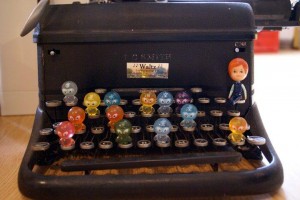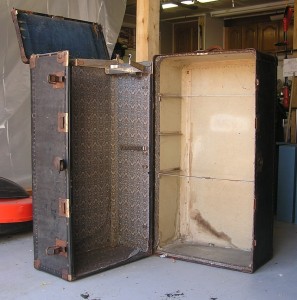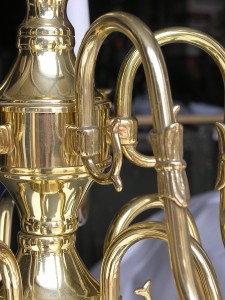One of the biggest issues we struggle with in the concept of a project revolves around the materials we use. We often repurpose old things by taking them apart, using their bits, and making something completely new. Sometimes we just start with the item intact and add to it. The issue comes in when it is something that is awesome just as it is, but non-functional in its current form.
So, here’s THE Question: When is it okay to transform something old into something new and when should leave well enough alone?
 We currently own 7 old manual-style typewriters dating from around 1913 through the 1950s. They are all complete, but not in working condition. We had intended to take them apart and use their pieces, but something in our hearts dies at the thought of all the old typewriters in the world being scavenged. So they sit in our workshop being adored by us, but serving no purpose.
We currently own 7 old manual-style typewriters dating from around 1913 through the 1950s. They are all complete, but not in working condition. We had intended to take them apart and use their pieces, but something in our hearts dies at the thought of all the old typewriters in the world being scavenged. So they sit in our workshop being adored by us, but serving no purpose.
Question #2: Is it better to take an object whose sole purpose in being created was to be used and enjoyed and give it a new life as something used and enjoyed, or are some antiques off limits for use and should be left as is to be visually enjoyed only?
 We recently posted a photo of an old wardrobe trunk on our Facebook page and asked our friends to guess what it was going to be. One of our friends commented that they thought it was pretty awesome just as it was. We tend to agree when it comes to old trunks, we own about 8 of them, but this particular trunk is in pretty rough interior condition. It is missing all of its internal bits such as the drawers, hangers, shelves, shoe box, and anything else it might have contained. It was pretty beat up on the outside as well, with a few of its sides showing cracks and warping. And, as most of the old trunks you find, it needs its lock latch replaced. No one would be storing anything in this without some major overhaul work. Thus, we feel justified in turning it into something other than a wardrobe trunk so it can continue its life as a useful thing.
We recently posted a photo of an old wardrobe trunk on our Facebook page and asked our friends to guess what it was going to be. One of our friends commented that they thought it was pretty awesome just as it was. We tend to agree when it comes to old trunks, we own about 8 of them, but this particular trunk is in pretty rough interior condition. It is missing all of its internal bits such as the drawers, hangers, shelves, shoe box, and anything else it might have contained. It was pretty beat up on the outside as well, with a few of its sides showing cracks and warping. And, as most of the old trunks you find, it needs its lock latch replaced. No one would be storing anything in this without some major overhaul work. Thus, we feel justified in turning it into something other than a wardrobe trunk so it can continue its life as a useful thing.
Question #3: If something is in really bad condition, how much of it do you try to salvage?
As we don’t have millions of dollars to spend restoring things to their original glory, we err on the side of keeping anything functional and replacing anything broken, soiled, or damaged beyond our repair skills. We like to believe that sometimes things find us, instead of us finding them. We take that trust seriously and do our best to care for these items and create a new existence for them.
We struggle with these questions about 5-10 times a day. M even has trouble making a decision about what to make out of the mountains of fabric she has hoarded because once it is turned into something it can’t become anything else. Yes, she worries about fabric reaching its full potential. (Nutter!)
If you are at all like us (which for your own sakes we hope it is a minimal amount, at least in this area) you know the pitfalls of second guessing yourself at every step and the paralyzing indecision that can result from being concerned about the fate of objects and pieces of history. No one wants to refinish that old side table only to find out on the Antiques Roadshow that it is now worthless but would have been worth a fortune had it been left alone.
 On the other hand, if it is yours and you will only use it if you make changes to it, then by all means make it usable! We like to treat our precious objects as members of the family. Personally, we don’t want to be put on a shelf and left to gather dust when our current state is no longer useful to those around us. We want to be reinvented, reinvigorated, and invited back into the fold with a new sense of purpose. And so, we try to do the same for our “stuff.”
On the other hand, if it is yours and you will only use it if you make changes to it, then by all means make it usable! We like to treat our precious objects as members of the family. Personally, we don’t want to be put on a shelf and left to gather dust when our current state is no longer useful to those around us. We want to be reinvented, reinvigorated, and invited back into the fold with a new sense of purpose. And so, we try to do the same for our “stuff.”
The bottom line, for us, is to treat items from the past with the respect they deserve. Quality workmanship, interesting features, and decorative elements should enhance our lives. The world is as beautiful as you see it. Spend a few moments imagining what amazing stories these little gems could tell. They have witnessed countless moments of people’s lives and by using them you are inviting them to witness yours. And THAT, we think, is the loveliest purpose of all.






May 17th, 2012 at 10:28 pm
As a lover of all good things in multiples, I couldn’t resist a post that starts out with “We currently own 7 old manual-style typewriters…” Glad to read that you opted to keep them as-is. All those crafty projects with vintage typewriter keys have bummed me out – the vintage typewriter will soon hit the endangered species list or its office equipment equivalent.
Liz
May 26th, 2012 at 11:15 am
We may yet take some of them apart, but we do make it a point to respect the original and its purpose in life. It would be very sad to see all the typewriters in the world dismantled and parted out. I mean, what will we create our post-apocalyptic subversive newspapers on?!?!? – M